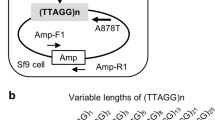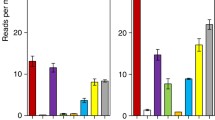Abstract
The presence of long repetitive sequences is demonstrated in the genome of the silkworm, Bombyx mori. Members of this BMC1 family reveal several features typical of the L1 (long interspersed sequence one) family of mammals, except for species specific elements. The number of BMC1 elements is estimated to be approximately 3500 per haploid genome. Elements containing the full length unit of 5.1 kb are dispersed throughout the genome and their restriction sites are conserved, although most members are preferentially truncated to varying extents at their 5′ ends. DNA sequencing indicates that this element contains six tandem repeats of 15 bp CpG-rich sequence in the 5′ proximal region. It terminates with a 3′ oligo(A) stretch, and is flanked at both ends by a 7–10 bp target sequence duplication. In addition, there is significant evidence for amino acid sequence homology with reverse transcriptase domains of other L1 families, especially F, Doc and lockey of Drosophila melanogaster. No large open reading frame is present. The BMC1 element is suggested to be dispersed in the genome by a transposition mechanism involving RNA intermediates.
Similar content being viewed by others
References
Benton WD, Davis RW (1977) Screening λgt recombinant clones by hybridization to single plaques in site. Science 196:180–182
Biessmann H, Valgeisrsdottir K, Lofsky A, Chin C, Ginther B, Levis RW, Pardue M-L (1992) HeT-A, a transposable element specifically involved in “healing” broken chromosome ends in Drosophila melanogaster. Mol Cell Biol 12:3910–3918
Bird AP (1986) CpG-rich islands and the function of DNA methylation. Nature 321:209–213
Brown SDM, Dover G (1981) Organization and evolutionary progress of a dispersed repetitive family of sequences in widely separated rodent genomes. J Mol Biol 150:441–466
Burton FH, Loeb DD, Chao SF, Hutchison III CA, Edgell MH (1985) Transposition of a long member of the L1 major interspersed DNA family into the mouse beta globin gene locus. Nucleic Acids Res 13:5071–5084
Chaboissier MC, Bussean I, Prossen J, Finnegan DJ, Bucheton A (1990) Identification of a potential RNA intermediate for transposition of the LINE-like element I factor in Drosophila malanogaster. EMBO J 9:3557–3563
Craigie R (1992) Hotspots and warm spots: integration specificity of retroelements. Trends Genet 8:187–190
Crowther PJ, Doherty JP, Linsenmeyer ME, Williamson MR, Woodcock DM (1991) Revised genomic consensus for the hypermethylated CpG island region of the human L1 transposon and integration sites of full length L1 elements from recombinant clones made using methylation-tolerant host strains. Nucleic Acids Res 19:2395–2401
Denhardt DT (1966) A membrane-filter technique for the detection of complementary DNA. Biochem Biophys Res Commun 23:641–646
Di Nocera PP, Casari G (1987) Related polypeptides are encoded by Drosophila F elements, I factors, and mammalian L1 sequences. Proc Natl Acad Sci USA 84:5843–5847
Dombroski BA, Mathias SL, Nanthakumar E, Scott AF, Kazazian Jr HH (1991) Isolation of an active human transposable element. Science 254:1805–1808
Dover GA (1982) Molecular drive: a cohesive mode of species evolution. Nature 299:111–117
Durnam DM, Gelinas RE, Myerson D (1985) Detection of species specific chromosomes in somatic cell hybrids. Somatic Cell and Molecular Genetics 11:571–577
Evans PE, Palmiter RD (1991) Retrotransposition of a mouse L1 element. Proc Natl Acad Sci USA 88:8792–8795
Everett RD, Baty D, Chambon P (1983) The repeated GC-rich motifs upstream from the TATA box are important elements of the SV40 early promoter. Nucleic Acids Res 11:2447–2464
Fanning T, Singer M (1987) The LINE-1 DNA sequencies in four mammalian orders predict proteins that conserve homologies to retrovirus proteins. Nucleic Acids Res 15:2251–2260
Finnegan DJ (1989) The 1 factor and I-R hybrid dysgenesis in Drosophila melanogaster. In: Berg DE, Howe MM (eds) Mobile DNA. American Society for Microbiology, Washington, DC, pp 503–517
Fujiwara H, Ogura T, Takada N, Miyajima N, Ishikawa H, Maekawa H (1984) Introns and their flanking sequences of Bombyx mori rDNA. Nucleic Acids Res 12:6861–6869
Fujiwara H, Ninaki O, Kobayashi M, Kusuda J, Maekawa H (1991) Chromosomal fragment responsible for genetic mosaicism in larval body marking of the silkworm, Bombyx mori. Genet Res 57:11–16
Furano AV, Robb SM, Robb FT (1989) The structure of the regulatory region of the rat L1 (L1Rn, long interspersed repeated) DNA family of transposable elements. Nucleic Acids Res 16:9215–9231
Gage LP (1992) The Bombyx mori genome; analysis by DNA reassociation kinetics. Chromosoma 45:27–42
Grandbastien M (1992) Retroelement in higher plants. Trends Genet 8:103–108
Hattori M, Hidaka S, Sakaki Y (1985) Sequence analysis of a KpnI family member near the 3′ end of the human-globin gene. Nucleic Acids Res 13:7813–7827
Heidmann O, Heidmann T (1991) Retrotransposition of a mouse IPA sequence tagged with an indicator gene. Cell 64:159–170
Hohjoh H, Minakami R, Sakaki Y (1990) Selective cloning and sequence analysis of the human L1 (LINE-1) sequences which transposed in the relatively recent past. Nucleic Acids Res 18:4099–4104
Hutchison III CA, Hardies SC, Loeb DD, Shehee WR, Edgell MH (1989) LINEs and related retroposons: long interspersed repeated sequences in the eucaryotic genome. In: Berg DE, Howe MM (eds) Mobile DNA. ASM, Washington, DC, pp 593–617
Ish-Horowicz D, Burke JF (1981) Rapid and efficient cosmic vector cloning. Nucleic Acids Res 9:2889–2998
Jakubczak JL, Burke WD, Eickbush TH (1991) Retrotransposable elements R1 and R2 interrupt the rRNA genes of most insects. Proc Natl Acad Sci USA 88:3295–3299
Jensen S, Heidmann T (1991) An indicator gene for detection of germline retrotransposition in transgenic Drosophila demonstrates RNA-mediated transposition of the LINE 1 element. EMBO J 10:1927–1937
Jubier-Maurin V, Dod BJ, Bellis M, Piechaczyk M, Roizes G (1985) Comparative study of the L1 family in the genus Mus possible role of retroposition and conversion events in its concerted evolution. J Mol Biol 184:547–564
Kazazian Jr HK, Wong C, Youssoufian H, Scott AF, Phillips DG, Antonarakis SE (1988) Haemophilia A resulting from de novo insertion of L1 sequences represents a novel mechanism for mutation in man. Nature 332:164–166
Leibold DM, Swergold GD, Singer MF, Thayer RE, Dombroski BA, Fanning TG (1990) Translation of LINE-1 DNA elements in vitro and in human cells. Proc Natl Acad Sci USA 87:6990–6994
Lerman MI, Thayer RE, Singer MF (1983) KpnI family of long interspersed repeated DNA sequences in primates: Polymorphism of family members and evidence for transcription. Proc Natl Acad Sci USA 80:3966–3970
Loeb DD, Padgett RW, Hardies SC, Shehee WR, Comer MB, Edgell MH, Hutchison III CA (1986) The sequence of a large L1Md element reveals a tandemly repeated 5′ end and several features found in retrotransposons. Mol Cell Biol 6:168–182
Luan DD, Korman MH, Jakubczak JL and Eickbush TH (1993) Reverse transcription of R2Bm RNA is primed by a nick at the chromosomal target site: a mechanism for non-LTR retrotransposition. Cell 72:595–605
McLean C, Bucheton A, Finnegan DJ (1993) The 5′ untranslated region of the I factor, a long interspersed nuclear element like retrotransposon of Drosophila melanogaster, contains an internal promoter and sequences that regulate expression. Mol Cell Biol 13:1042–1050
Maekawa H, Takada N, Mikitani K, Ogura T, Miyajima N, Fujiwara H, Kobayashi M, Ninaki O (1988)_Nucleolus organizers in the wild silkworm Bombyx mandarina and the domesticated silkworm B. mori. Chromosoma 96:263–269
Maniatis T, Fritsch EF, Sambrook J (1982) In: Molecular cloning. Cold Spring Harobr Laboratory Press, New York, pp 475–478
Manuelidis L, Ward DC (1984) Chromosomal and nuclear distribution of the Hind III 1–9-kb human DNA repeat segment. Chromosoma 91:28–38
Maxam AM, Gilbert W (1980) Sequencing end-labeled DNA with base-specific chemical cleavages. Methods Enzymol 65:499–560
Michaille J-J, Garel A, Prudhomme J-C (1990) Cloning and characterization of the highly polymorphic Ser2 gene of Bombyx mori. Gene 86:177–184
Mizrokhi LJ, Georgieva SG, Ilyin YV (1988) Jockey, a mobile Drosophila element similar to mammalian LINEs, is transcribed from the internal promoter by RNA polymerase II. Cell 54:685–691
Moore G, Cheung W, Schwarzacher T, Flavell R (1991) BIS 1, a major component of the cereal genome and a tool for studying genomic organization. Genomics 10:469–476
Ninaki O, Takada N, Fujiwara H, Ogura T, Miyajima N, Kiyota A, Maekawa H (1989) Gene analysis by blot hybridization on the silkworm Bombyx mori cell lines. In: Mitsuhashi J (ed) Invertebrate cell systems in applications, vol 1. CRC Press, Boca Raton, FL, pp 143–149
Nur I, Pascale E, Furano AV (1988) The left end of rat L1 (L1Rn, long interspersed repeated) DNA which is a CpG island can function as a promoter. Nucleic Acids Res 16:9233–9251
Okamoto H, Ishikawa E, Suzuki Y (1982) Structural analysis of sericin genes: homologies with fibroin gene in the 5′ flanking nucleotide sequences. J Biol Chem 257:15192–15199
Okazaki S, Isuchida K, Maekawa H, Ishikawa H and Fujiwara H (1993) Identification of a pentanucleotide telomeric sequence, (TTAGG)n, in the silkworm Bombyx mori and in other insects. Mol Cell Biol 13:1424–1432
Pelisson A, Finnegan DJ, Bucheton A (1991) Evidence for retrotransposition of the I factor, a LINE element of Drosophila melanogaster. Proc Natl Acad Sci USA 88:4907–4910
Pinkel D, Gray JW, Trask B, van den Engh G, Fuscoe J, van Dekken H (1987) Cytogenetic analysis by in situ hybridization with fluorescently labeled nucleic acid probes. Cold Spring Harber Symp Quant Biol LI:151–157
Sakai N, Mori S, Izumi S, Haino-Fukushima K, Ogura T, Maekawa H, Tomino S (1988) Structure and expression of mRNAs coding for major plasma proteins of Bombyx mori. Biochim Biophys Acta 949:224–232
Sanger F, Nicklen S, Coulson AR (1977) DNA sequencing with chain-terminating inhibitors. Proc Natl Acad Sci USA 74:5463–5467
Shyman S, Weaver S (1985) Chromosomal rearrangements associated with LINE elements in the mouse genome. Nucleic Acids Res 13:5085–5093
Singer MF (1982) SINEs and LINEs: Highly repeated short and long interspersed sequences in mammalian genomes. Cell 28:433–434
Southern EM (1975) Detection of specific sequences among DNA fragments separated by gel electrophoresis. J Mol Biol 98:503–517
Tsujimoto Y, Suzuki Y (1984) Natural fibroin genes purified without using cloning procedures from fibroin producing and-nonproducing tissues reveal indistinguishable structure and function. Proc Natl Acad Sci USA 81:1644–1684
Vizard DL, Yarsa J (1985) Comparison of genomic fragment and clone sequence within a long interspersed repeated sequence of the mouse genome. Nucleic Acids Res 13:473–484
Xiong Y, Eickbush TH (1988a) The site specific ribosomal DNA insertion element RF1Bm belongs to a class of non-long-terminal repeat retroposons. Mol Cell Biol 8:114–123
Xiong Y, Eickbush TH (1988b) Functional expression of a sequence-specific endonuclease encoded by the retrotransposon R2Bm. Cell 55:235–246
Xiong Y, Eickbush TH (1990) Origin and evolution of retroelements based upon their reverse transcriptase sequences. EMBO J 9:3353–3362
Xiong Y, Burke WD, Jakubczak JL, Eickbush TH (1988) Ribosomal DNA insertion elements R1Bm and R2Bm can transpose in a sequence specific manner to locations outside the 28S genes. Nucleic Acids Res 16:10561–10573
Author information
Authors and Affiliations
Rights and permissions
About this article
Cite this article
Ogura, T., Okano, K., Tsuchida, K. et al. A defective non-LTR retrotransposon is dispersed throughout the genome of the silkworm, Bombyx mori . Chromosoma 103, 311–323 (1994). https://doi.org/10.1007/BF00417878
Received:
Revised:
Accepted:
Issue Date:
DOI: https://doi.org/10.1007/BF00417878




